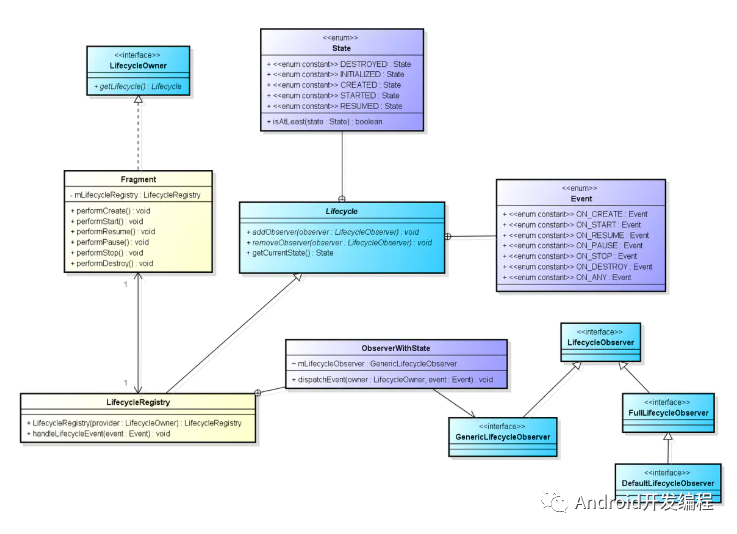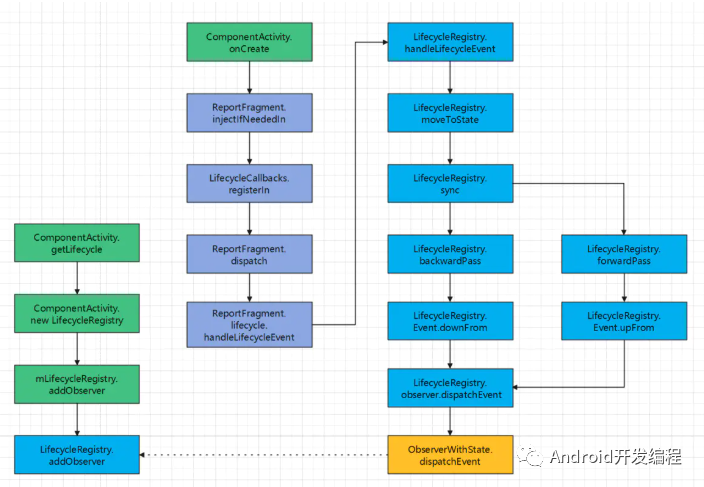前言
如何利用 android.arch.lifecycle 包提供的类来控制数据、监听器等的 lifecycle。同时,LiveData 与 ViewModel 的 lifecycle 也依赖于 Lifecycle 框架;
今天我们就来聊聊lifecycle的实现原理,来一波分析
一、为什么要引进Lifecycle?
1、没有引进Lifecycle做法
- 在处理Activity或者Fragment组件的生命周期相关时,不可避免会遇到这样的问题;
- 在Activity的onCreate()中初始化某些成员(比如MVP架构中的Presenter,或者AudioManager、MediaPlayer等),然后在onStop中对这些成员进行对应处理,在onDestroy中释放这些资源,这样导致我们的代码也许会像这样;
- class MyPresenter{
- public MyPresenter() {
- }
- void create() {
- //do something
- }
- void destroy() {
- //do something
- }
- }
- class MyActivity extends AppCompatActivity {
- private MyPresenter presenter;
- public void onCreate(...) {
- presenter= new MyPresenter ();
- presenter.create();
- }
- public void onDestroy() {
- super.onDestroy();
- presenter.destory();
- }
- }
代码没有问题,关键问题是,实际生产环境中 ,这样的代码会非常复杂,你最终会有太多的类似调用并且会导致 onCreate() 和 onDestroy() 方法变的非常臃肿;
2、引进Lifecycle做法
Lifecycle 是一个类,它持有关于组件(如 Activity 或 Fragment)生命周期状态的信息,并且允许其他对象观察此状态;
代码如下:
Prestener继承LifecycleObserver接口
- public interface IPresenter extends LifecycleObserver {
- @OnLifecycleEvent(Lifecycle.Event.ON_CREATE)
- void onCreate(@NotNull LifecycleOwner owner);
- @OnLifecycleEvent(Lifecycle.Event.ON_DESTROY)
- void onDestroy(@NotNull LifecycleOwner owner);
- @OnLifecycleEvent(Lifecycle.Event.ON_ANY)
- void onLifecycleChanged(@NotNull LifecycleOwner owner,
- @NotNull Lifecycle.Event event);
- }
- public class BasePresenter implements IPresenter {
- private static final String TAG = "com.qingmei2.module.base.BasePresenter";
- @Override
- public void onLifecycleChanged(@NotNull LifecycleOwner owner, @NotNull Lifecycle.Event event) {
- }
- @Override
- public void onCreate(@NotNull LifecycleOwner owner) {
- Log.d("tag", "BasePresenter.onCreate" + this.getClass().toString());
- }
- @Override
- public void onDestroy(@NotNull LifecycleOwner owner) {
- Log.d("tag", "BasePresenter.onDestroy" + this.getClass().toString());
- }
- }
直接将我想要观察到Presenter的生命周期事件都列了出来,然后封装到BasePresenter 中,这样每一个BasePresenter 的子类都能感知到Activity容器对应的生命周期事件,并在子类重写的方法中,对应相应行为
在Activity/Fragment容器中添加Observer
- public class MainActivity extends AppCompatActivity {
- private IPresenter mPresenter;
- @Override
- protected void onCreate(Bundle savedInstanceState) {
- super.onCreate(savedInstanceState);
- Log.d("tag", "onCreate" + this.getClass().toString());
- setContentView(R.layout.activity_main);
- mPresenter = new MainPresenter(this);
- getLifecycle().addObserver(mPresenter);//添加LifecycleObserver
- }
- @Override
- protected void onDestroy() {
- Log.d("tag", "onDestroy" + this.getClass().toString());
- super.onDestroy();
- }
- }
每当Activity发生了对应的生命周期改变,Presenter就会执行对应事件注解的方法
二、Lifecycle原理层层深入分析
在Activity 获取 Lifecycle,实际上是通过Activity的父类 ComponentActvitiy 获取,父类实现了 LifecycleOwner 接口,就能获取 Lifecycle ,最后注册 LifecycleObserver 就能拿到生命周期回调了
1、 onCreate
- 在ComponentActvitiy的 onCreate 方法里面可以看到 ReportFragment 的创建。
- /* ComponentActvitiy */
- @Override
- protected void onCreate(@Nullable Bundle savedInstanceState) {
- ...
- ReportFragment.injectIfNeededIn(this);
- ...
- }
2、 getLifecycle方法
- /* ComponentActvitiy */
- private final LifecycleRegistry mLifecycleRegistry = new LifecycleRegistry(this);
- @NonNull
- @Override
- public Lifecycle getLifecycle() {
- return mLifecycleRegistry;
- }
- Life
3、 Lifecycle.Event
Lifecycle.Event 是个枚举类,这里的生命周期 Event 并不是Fragment的,在后面的生命周期处理时会用上的。
- public enum Event {
- ON_CREATE,
- ON_START,
- ON_RESUME,
- ON_PAUSE,
- ON_STOP,
- ON_DESTROY,
- ON_ANY;
- ...
- }
4、 ReportFragment的创建
ReportFragment 是一个 没有界面的Fragment,如果有了解过Glide原理的同学,应该也知道这个方法,就是通过看不见的Fragment,来感知生命周期,让使用者无需考虑生命周期的问题。
在SDK29以上的版本 使用的是 LifecycleCallbacks.registerIn(activity)。
- /* ReportFragment */
- public static void injectIfNeededIn(Activity activity) {
- if (Build.VERSION.SDK_INT >= 29) {
- // On API 29+, we can register for the correct Lifecycle callbacks directly
- LifecycleCallbacks.registerIn(activity);
- }
- // Prior to API 29 and to maintain compatibility with older versions of
- // ProcessLifecycleOwner (which may not be updated when lifecycle-runtime is updated and
- // need to support activities that don't extend from FragmentActivity from support lib),
- // use a framework fragment to get the correct timing of Lifecycle events
- android.app.FragmentManager manager = activity.getFragmentManager();
- if (manager.findFragmentByTag(REPORT_FRAGMENT_TAG) == null) {
- manager.beginTransaction().add(new ReportFragment(), REPORT_FRAGMENT_TAG).commit();
- // Hopefully, we are the first to make a transaction.
- manager.executePendingTransactions();
- }
- }
5、 LifecycleCallbacks.registerIn(activity)
LifecycleCallbacks 实现了 Application.ActivityLifecycleCallbacks接口,在SDK29以上的生命周期分发是由Application 分发的,activity注册就能回调。
大名鼎鼎的LeakCanary在监听Activity生命周期,也是使用
- Application.ActivityLifecycleCallbacks。
- @RequiresApi(29)
- static class LifecycleCallbacks implements Application.ActivityLifecycleCallbacks {
- static void registerIn(Activity activity) {
- activity.registerActivityLifecycleCallbacks(new LifecycleCallbacks());
- }
- ...
- @Override
- public void onActivityPostCreated(@NonNull Activity activity,
- @Nullable Bundle savedInstanceState) {
- dispatch(activity, Lifecycle.Event.ON_CREATE);
- }
- ...
- }
6、 ReportFragment.dispatch 版本兼容
如果SDK版本小于29,ReportFragment的各个生命周期方法里,会调用 dispatch 方法。
比如 onActivityCreated。
反正无论是使用 LifecycleCallbacks.registerIn(activity),还是 Fragment 的生命周期回调,最后都会dispatch。
- @Override
- public void onActivityCreated(Bundle savedInstanceState) {
- super.onActivityCreated(savedInstanceState);
- dispatchCreate(mProcessListener);
- dispatch(Lifecycle.Event.ON_CREATE);
- }
- private void dispatch(@NonNull Lifecycle.Event event) {
- if (Build.VERSION.SDK_INT < 29) {
- // Only dispatch events from ReportFragment on API levels prior
- // to API 29. On API 29+, this is handled by the ActivityLifecycleCallbacks
- // added in ReportFragment.injectIfNeededIn
- dispatch(getActivity(), event);
- }
- }
- static void dispatch(@NonNull Activity activity, @NonNull Lifecycle.Event event) {
- if (activity instanceof LifecycleRegistryOwner) {
- ((LifecycleRegistryOwner) activity).getLifecycle().handleLifecycleEvent(event);
- return;
- }
- if (activity instanceof LifecycleOwner) {
- Lifecycle lifecycle = ((LifecycleOwner) activity).getLifecycle();
- if (lifecycle instanceof LifecycleRegistry) {
- ((LifecycleRegistry) lifecycle).handleLifecycleEvent(event);
- }
- }
- }
7、 Lifecycle.State
State只有5个但是生命周期可是不止5个,所以Google他们设计时,就创建流程正着走,销毁流程就反正走。
- Lifecycle.State
- /* Lifecycle.State */
- public enum State {
- DESTROYED,
- INITIALIZED,
- CREATED,
- STARTED,
- RESUMED;
- public boolean isAtLeast(@NonNull State state) {
- return compareTo(state) >= 0;
- }
- }
8、 handleLifecycleEvent
LifecycleRegistryOwner 也是继承 LifecycleOwner,所以他们最后都会执行 LifecycleRegistry 的 handleLifecycleEvent 方法。
就是把 Lifecycle.Event处理一下,转化成 Lifecycle.State
- /* Lifecycle.Event */
- @NonNull
- public State getTargetState() {
- switch (this) {
- case ON_CREATE:
- case ON_STOP:
- return State.CREATED;
- case ON_START:
- case ON_PAUSE:
- return State.STARTED;
- case ON_RESUME:
- return State.RESUMED;
- case ON_DESTROY:
- return State.DESTROYED;
- case ON_ANY:
- break;
- }
- throw new IllegalArgumentException(this + " has no target state");
- }
- Lifecycle.State 继续往下传,先用 mState 保存,再 sync 方法处理。
- /* LifecycleRegistry */
- public void handleLifecycleEvent(@NonNull Lifecycle.Event event) {
- enforceMainThreadIfNeeded("handleLifecycleEvent");
- moveToState(event.getTargetState());
- }
- private void moveToState(State next) {
- if (mState == next) {
- return;
- }
- //保存state状态
- mState = next;
- if (mHandlingEvent || mAddingObserverCounter != 0) {
- mNewEventOccurred = true;
- // we will figure out what to do on upper level.
- return;
- }
- mHandlingEvent = true;
- sync();
- mHandlingEvent = false;
- }
9、 sync
这里利用上一个方法保存的mState,用于比较,判断是正向执行还是反向执行生命周期
- /* LifecycleRegistry */
- private void sync() {
- //这是弱引用包装过的LifecycleOwner
- LifecycleOwner lifecycleOwner = mLifecycleOwner.get();
- if (lifecycleOwner == null) {
- throw new IllegalStateException("LifecycleOwner of this LifecycleRegistry is already"
- + "garbage collected. It is too late to change lifecycle state.");
- }
- while (!isSynced()) {
- mNewEventOccurred = false;
- // no need to check eldest for nullability, because isSynced does it for us.
- //上一个方法保存的mState,跟组件之前的的mState对比
- if (mState.compareTo(mObserverMap.eldest().getValue().mState) < 0) {
- //返向执行流程
- backwardPass(lifecycleOwner);
- }
- Map.Entry<LifecycleObserver, ObserverWithState> newest = mObserverMap.newest();
- if (!mNewEventOccurred && newest != null
- && mState.compareTo(newest.getValue().mState) > 0) {
- //正向执行流程
- forwardPass(lifecycleOwner);
- }
- }
- mNewEventOccurred = false;
- }
10、 forwardPass
反向的逻辑差不多,只是执行 backwardPass ,先转换Stata,最后执行 observer.dispatchEvent。
这里又把 Lifecycle.State 转回 Lifecycle.Event,然后给观察者分发出去。
- /* Lifecycle.Event */
- @Nullable
- public static Event upFrom(@NonNull State state) {
- switch (state) {
- case INITIALIZED:
- return ON_CREATE;
- case CREATED:
- return ON_START;
- case STARTED:
- return ON_RESUME;
- default:
- return null;
- }
- }
转换 Event.upFrom ,发送 observer.dispatchEvent。
- /* LifecycleRegistry */
- private void forwardPass(LifecycleOwner lifecycleOwner) {
- Iterator<Map.Entry<LifecycleObserver, ObserverWithState>> ascendingIterator =
- mObserverMap.iteratorWithAdditions();
- while (ascendingIterator.hasNext() && !mNewEventOccurred) {
- Map.Entry<LifecycleObserver, ObserverWithState> entry = ascendingIterator.next();
- ObserverWithState observer = entry.getValue();
- while ((observer.mState.compareTo(mState) < 0 && !mNewEventOccurred
- && mObserverMap.contains(entry.getKey()))) {
- pushParentState(observer.mState);
- //转化
- final Event event = Event.upFrom(observer.mState);
- if (event == null) {
- throw new IllegalStateException("no event up from " + observer.mState);
- }
- //发送
- observer.dispatchEvent(lifecycleOwner, event);
- popParentState();
- }
- }
- }
11、 发送生命周期状态
ObserverWithState 发送出 Lifecycle.Event ,至此就结束了,有注册订阅关系的地方就能收到
- static class ObserverWithState {
- State mState;
- LifecycleEventObserver mLifecycleObserver;
- ObserverWithState(LifecycleObserver observer, State initialState) {
- mLifecycleObserver = Lifecycling.lifecycleEventObserver(observer);
- mState = initialState;
- }
- /* 分发生命周期状态 */
- void dispatchEvent(LifecycleOwner owner, Event event) {
- State newState = event.getTargetState();
- mState = min(mState, newState);
- mLifecycleObserver.onStateChanged(owner, event);
- mState = newState;
- }
- }
原理比较清晰:Activity/Fragment实现LifecycleOwner接口,通过LifecycleRegistry在对应生命周期分发事件Lifecycle.Event,回调到生命周期观察者LifecycleObserver对应订阅方法

总结
Lifecycle还是有可取之处的,相对于其它架构组件之间的配合,Lifecycle更简单且独立;
LifecycleObserver接口( Lifecycle观察者):实现该接口的类,通过注解的方式,可以通过被LifecycleOwner类的addObserver(LifecycleObserver o)方法注册,被注册后,LifecycleObserver便可以观察到LifecycleOwner的生命周期事件;
LifecycleOwner接口(Lifecycle持有者):实现该接口的类持有生命周期(Lifecycle对象),该接口的生命周期(Lifecycle对象)的改变会被其注册的观察者LifecycleObserver观察到并触发其对应的事件;
Lifecycle(生命周期):和LifecycleOwner不同的是,LifecycleOwner本身持有Lifecycle对象,LifecycleOwner通过其Lifecycle getLifecycle()的接口获取内部Lifecycle对象;
State(当前生命周期所处状态);
Event(当前生命周期改变对应的事件),当Lifecycle发生改变,如进入onCreate,会自动发出ON_CREATE事件;
后面会陆续介绍一些官方架构方面的知识点;
本文转载自微信公众号「Android开发编程」





























